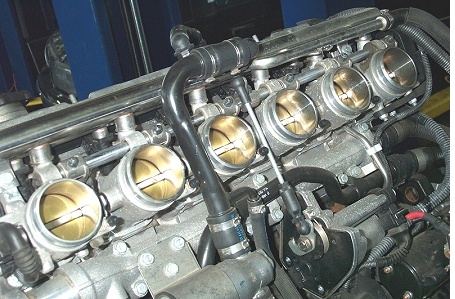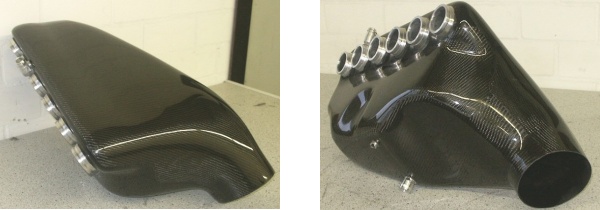|
|
|
|
|
| Carbon Fiber "CSL-Style" Airbox for the E46 M3 |
|
|
 The six hungry throttles on an S54 engine...
The six hungry throttles on an S54 engine...
The mission of the airbox (or "plenum") is feeding these throttles a healthy diet of air. |
|
The S54 engine for the E46 M3 has 6 individual throttle bodies to feed its 6 cylinders. One throttle per cylinder is about as good as it gets from an intake tuning point of view. Because of these six seperate intake paths, and the fact that the intake air only passes through one single air filter and one single MAF sensor (mass-air-flow), a plenum is needed in order to distribute the incoming air to the six throttle body trumpets. There exists a carbon fiber airbox for the S54 engine which some German tuners claim will produce more horsepower by virtue of providing a cleaner flow path of air into the inlet trumpets. This German CF airbox is quite similar to the unit that BMW designed for the E46 M3 CSL. The CF airbox is ostensibly intended for use with an Alpha-N type of engine management system but, at least in Germany, has also been adapted for use with a larger MAF (this does require a special air inlet and filter arrangement). This type of airbox should not be considered a "bolt-on" mod. It will absolutely require proper software to work correctly. And unless converting the engine to Alpha-N any gains in power won't be huge, and may in fact be accompanied by a loss of low and mid-range torque. An airbox such as this is ultimately suited to a highly developed race engine. A comparison of the factory E46 M3 airbox and the German CF airbox is shown in the following photograph: |

|
|
One can see the yellow colored intake trumpets in the BMW factory airbox. The German CF airbox has very similar trumpets molded from carbon fiber and bonded to the plenum. Both types of trumpets are flared and have an angled end-cut. These two features are most likely included to distribute the pulse-tuning effect over a wider rpm range (think Megaphone in reverse). The German CF airbox trumpets are not quite as flared as those on the factory piece. |
|
One possible performance limitation of the factory airbox is that due to packaging constraints, the inlet trumpets end up facing the opposite side of the airbox with not that much space in-between for a smooth airflow pathway. The CSL style German CF airbox allows an intuitively smoother flow of air into the trumpets. This is illustrated in the following sketch: |

|
|
The trumpets are shown as being the same length in both styles of airbox, but there is no reason that this is necessarily the case. However, the diagram does convey the general idea. Also note that the CSL-style airbox has a larger volume than the factory airbox which will change the Helmholtz resonance frequency. It is unclear to the author whether the design of the CF airbox takes this expressly into account. Already on the E30 M3 S14 racecars of 1988 vintage the factory was converting to a carbon fiber airbox quite similar to the CSL-style unit (except designed for 4 cylinders, click here for more info). |

One source for carbon fiber CSL-style airboxes is the e46shop in Germany. As mentioned above, keep in mind that this airbox is not a drop-in replacement for the factory unit. You will need to relocate the existing MAF (perhaps a larger MAF from another application), or you will need to convert to throttle position based engine management (Alpha-N). In either case new software will be required. It is important to note that a CF airbox like this is likely to change the powerband of the engine, moving the usable rev-band to a higher range (at the expense of low and mid range torque production). With conversion to Alpha-N this change to the power band might not be as pronounced, since conversion to Alpha-N on previous versions of M3 engines is usually reported to boost the whole power curve upwards (low, mid and high). Certainly if one were really developing an S54 engine with extensive internal mods such as cams, porting etc., as well as converting to Alpha-N with some aftermarket programmable engine management (Motec, Tec III...), then in this author's opinion incorporating an airbox like this one would be a good idea. However, there is at least one club racer in the U.S. who had very unfavorable results when trying to run a Hamann airbox, which is very similar to the CF unit shown here (the state of development of his engine is not known to me). Thus ultimately, as with so many things, the user will have to try it out and see if it works for them. |
|